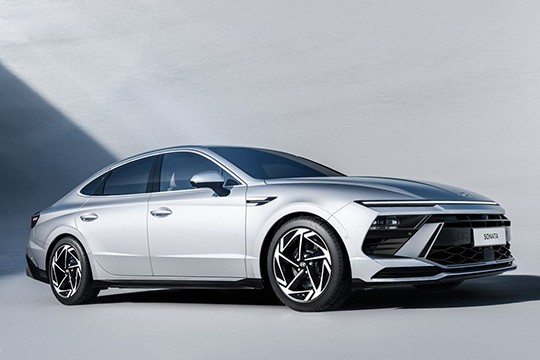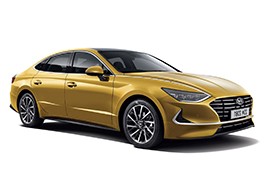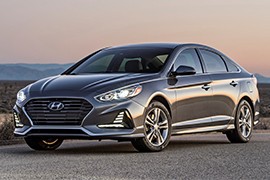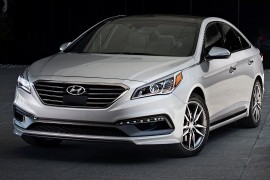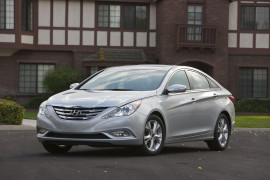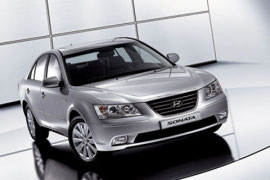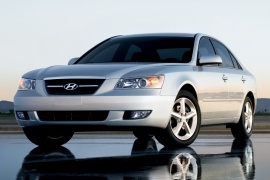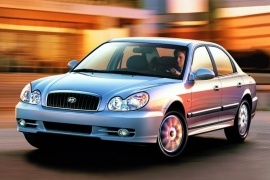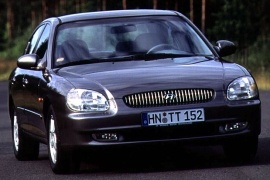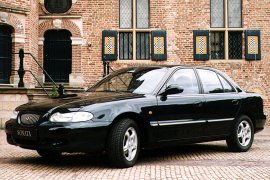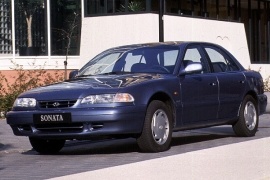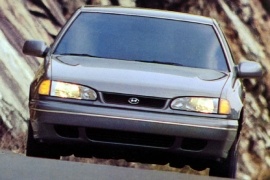HYUNDAI Sonata Models/Series Timeline, Specifications & Photos
First production year: 1989
Engines: Gasoline, Hybrid, Diesel
Hyundai refreshed the eighth generation of the Sonata at the beginning of 2023 for the 2024 model-year, thus improving the car's look both on the inside and the outside.
The Korean automaker refreshed the Sonata after four years after the launch of the eighth generation of this model. Even though its styling was not outdated nor dull, the mid-size sedan had already started to show its age. Furthermore, the technological package was also updated, with a new infotainment system and a new dashboard and instrument panel.
Thanks to its continuous light strip across the front fascia, the refreshed eighth generation of the Sonata looked like it was ready for the future. All the other main components of the front fascia were placed underneath that signature light. On the sides, the LED headlights were above side scoops while the main grille took center stage, adorned with a hexagonal pattern. From its profile, the fastback silhouette was just an illusion since the vehicle was a three-box sedan but with a raked forward rear windscreen.
Inside, the most striking new element was the dashboard. Hyundai installed a new combo of an instrument panel and infotainment unit, both being protected by the same glass panel. This idea was already present in other Hyundai models, such as the Elantra of the Ioniq6. Both displays wore the same 12.5” diagonal size, and the result was spectacular. The door panels looked like they sported a slightly altered design. At the same time, the seats were available with new upholstery colors. Yet, in the back, adults had some problems with the headroom.
This is the eight Sonata from Hyundai. It sounds just about right, maybe with a few notes on and off the musical stave. The look, the options and some of its new features are great. But some ideas might be wrong.
Hyundai doesn't look too concerned if they will lose some customers aged over 40 or 50 years old. Their bet is for the younger drivers and this is why they designed the 2020 Sonata with a sportier look and a lower stance on the road.
Total length has been increased compared to the previous generation by 45 mm (1 in) reaching a total of 4.9 m (192.9 in). The roofline is sloped toward the rear, giving the Sonata a sports-coupe look.
On the interior, the Sonata has been reworked extensively, adding a touch of luxury and a spice of modernism due to its Bose infotainment system equipped to pair with Android Auto and Apple CarPlay. But the redesigned steering wheel looks like it plays a different song than the rest of this Sonata, with a weird-looking 4-spoke design.
Under the hood, though, the engine department didn't play the right note since they are offering only two engine choices. Both of them are four-bangers: one is a 2.5-liter naturally aspirated, which offers 191 HP, and the other is a 1.6-liter turbo with 180 HP. For the transmission, Hyundai offers an 8-speed automatic version for the 1.6-liter.
Hyundai introduced the seventh generation of the Sonata in 2014 and, three years later, it brought a facelift for it and sharpened its image.
The Korean carmaker tried to make the Sonata a trustworthy alternative for premium-segment vehicles, and it constantly upgraded the lineup so it could match the offer of its competitors. Even though it wasn't an old car by any standards, the 2017 Sonata came with important upgrades over the 2014 model.
With so many body panels changed, it was hard to say that it was a facelift and not a new generation. Apart from the roof, Hyundai changed every other body panel. Its front grille changed from the four-slats type to a 3D cascade-type. There were new LED headlights, fog-lights and DRLs. Its reshaped bumper featured taller outer side pods. For the hood, the designers created new lines that suggested power domes. In the back, the taillights were angular, pointing toward the badge with a clear horizontal line for the reversing lights. The Hyundai badge hid the button for trunk opening.
Inside, the carmaker added a few modifications to match the exterior's new look. Its instrument panel design and the three-spoke steering wheel were slightly enhanced, while the piano key buttons for the audio and HVAC controls gave a premium look for the center stack.
Technically, the Sonata received an updated front suspension with a thicker torsion bar to improve the steering response. At the back, the carmaker made the rear suspension stiffer to provide better handling and manage heavy loads. Last but not least, the 2.0-liter turbocharged version was paired to an eight-speed automatic transmission.
The seventh generation of the Hyundai Sonata was launched in March 2014 as a 2015 model and it was designed with agility in mind but without giving up the comfort features.
The sweeping lines of the Sonata kept the same design cues from its smaller siblings such as the Elantra. In Europe, the Sonata wasn't available, but its twin brother iX40 was. The large sedan faced a new image with its large, cascading grille as it was named by its designer. It featured three horizontal lines that looked like they are flowing one on top of the other.
The new swept lines made the car look like it had a liquid body and it was hit with a strong, frontal, wind. The raked windshield started the curved line of the greenhouse. The ascending side-line ended-up on the rear taillights. On top of the trunk, a small lip was installed on some versions. The double twin exhausts in the rear might tell something about a performance car, but the Hyundai Sonata it wasn't. It just didn't fit the overall design.
Inside, there was room for five adults, but the rear mid passenger had to sit on top of a bulky center tunnel even though the car was front-wheel drive and it didn't have an all-wheel-drive version. The instrument cluster was a mix between round dials and a TFT display.
The standard transmission was a six-speed automatic with paddle shifters behind the steering wheels. It was available only with the four-pot engine and the top version offered 245 hp, which was not so impressive for a car of its size, not to mention that the sixth generation of the Sonata had mode power on its top version.
The sixth generation of the Hyundai Sonata showed no rest for the Korean car-manufacture in improving its mid-size sedan representative on the U.S. market.
The Sonata fought all the way up to the level of the established mid-size sedans in the American market. It improved every single model
it had from generation to generation and it didn't slow down the pace with the 2011 Sonata. It was launched in 2009 in the Korean market and a year later on the North American continent, as a 2011 model.
The sixth generation of the Sonata had a totally new design over the previous generation. Its fluid design is a reminiscence of the bio-design era, imagined by Pininfarina in the late '60s. But the Koreans just named it "fluid design". Its elongated headlights over the fenders and hood gave a nicer look for the Sonata, a vehicle that didn't have a proper design on some of its previous generations.
Inside, the 2011 Sonata features better quality materials and a design inspired by upscale, premium sedans. A new center console and instrument panel borrowed some cues from the Hyundai Veracruz. For the infotainment system, a new touch-scree display with navigation was offered as an option, while the standard was a radio-CD-MP3 player with USB and AUX-in jack.
The engine offer started with a 2.4-liter unit, and the top version was a 3.3-liter V6. While the four-cylinder was mated as standard to a 5-speed manual, the V6 featured a 5-speed automatic SHIFTRONIC transmission.
Hyundai refreshed the fifth generation of the Sonata in 2008 and targeted the same customers as the Honda Accord and the Toyota Camry, but at a lower price.
Since the world financial crisis was already claiming its victims, Hyundai was successful in getting a bigger slice of the market. The Korean automaker policy was to provide its flagship sedan with everything so the customers didn't have to pay extra for something. Moreover, for those who wanted more, there were some higher trim levels. But even the basic model had everything a regular family needed.
Hyundai was already working on the sixth generation of the Sonata when it brought the facelifted version of the Sonata V. While it didn't stand out on the road with its look, it won the wallets of many. At the front, the new grille tried to look more stylish with its three-slat design, while a new set of headlights with an angular design replaced the older ones. From its profile, the Sonata unveiled new alloy wheels design. At the back, the automaker installed LED taillights.
The evolution continued on the interior, where the Sonata facelift received a new center stack and instrument panel. Moreover, all versions featured 3.5mm AUX-in and USB, while the upper trim levels got iPod connectivity. In addition, a touch-screen sat-nav was available as an option.
Under the hood, Hyundai installed a new generation of Theta II, 2.4-liter inline-four engines paired as standard with a five-speed manual or a five-speed automatic. The range-topping version got a revised version of the Hyundai's 3.3-liter V6 that pumped 15 more hp than on the non-facelifted version.
The Sonata nameplate was around since 1985 and it was produced by the South Korean manufacturer, Hyundai.
The mid-size sedan was one of the easiest to maintain in its class.
In 2004, the fifth generation of the Sonata was launched in Korea. It was based on the NF project, featuring a new platform.
The Sonata offered a variety of engines to choose from: a 2.4-liter developing 164 hp, a 3.3-liter V6 with 237 hp and a 2.0-liter engine that was only available in Korea.
The Sonata offered great seating space for 5 adults and the trunk size was great for longer journeys.
Considering the starting price of a Sonata, a fair $17,000, the sedan offered a nicely finished interior with intuitively placed controls.
Available with three trim levels, even the base model was well equipped with air conditioning, side-impact airbags, power mirrors, power locks with keyless remote, cruise control, power windows and others. The 2.4-liter standard engine could be mated to a 5-speed manual or a 4-speed automatic transmission that cost $800.
The top of the range, the LX model, brought lots of features and included leather upholstery, an automatic climate control and an 8-way power driver’s seat.
Additionally, the Sonata could be equipped with a power tilt-and-slide glass sunroof, anti-lock brakes and an electrochromic rear-view mirror.
Hyundai looked very determined to enhance its lineup and get its spot in the world's top charts, and the refreshed fourth generation of the Sonata was solid proof.
The Korean carmaker started to build its name slowly, in a trial by fire method. It didn't get down on its knees with the first generations of the Elantra or Pony. Its partnership with Mitsubishi helped the Korean engineers build a better car and their marketing department what to offer on the market. First, Hyundai improved the quality, and then, it started to improve its products. While the 2001 Sonata was not on top of its class, it showed a clear sign of understanding of the learning curve.
After the facelift, the Sonata lost part of its bland design, but now it showed some inspiration from European carmakers such as Mercedes-Benz or Jaguar. The headlights resembled a similar shape of the quad-headlights design from the E-Class, while the car's back resembled the Jaguar S-Type. The car's flowing lines were in the same trend as those from the biodesign era.
Inside, the Sonata featured standard amenities, which were available only at extra costs on its competitors. The Korean carmaker understood that to sell a car for those looking for a premium vehicle. It has to offer a leather-wrapped interior, wood-trims, and lots of standard equipment. The Sonata had them all, including automatic climate control, CD-stereo, and power-seats. The sunroof was on the options list.
Under the hood, Hyundai installed its 2.7-liter Delta engine, developed together with Bosch. It offered enough power for the car. For the European market, the top-selling version was the 2.0-liter version. All versions were available with either a 5-speed manual or an automatic transmission.
By 1998, Hyundai already started to understand how to build its cars and what customers want from a specific segment, and the Sonata was mostly a good answer.
It only took Hyundai 13 years between the first and the fourth Sonata generation, and that included a facelift for the third generation. The Korean carmaker worked double or triple shifts to catch-up with the big-guys in the automotive industry. In 1998, they were still behind, but they were closing the gaps in many areas. Their cars were no longer lemons, and despite using some inexpensive materials, the results were far better than before.
The only downside for the fourth Sonata generation was the design. Hyundai still didn't know how to merge the panels and lines and glass areas to create a beautiful vehicle. On the other hand, its cars didn't top the ugliness charts either. The Sonata was rather bland, with lines and lights that looked like they were melted. A wide chromed slat stood proud between the reversing lights with the name Sonata on it. It was a statement that showed the car's name on the road; maybe not the most pleasant one.
Apart from some low-quality plastics spread here and there, the Sonata was fit for families, fleet owners and middle management. The velour upholstery was standard, while the full-options version spoiled its users with leather seats, (plastic) wood-trims, sunroof, automatic transmission, and a high-quality sound system.
Under the hood, Hyundai installed two engine choices, both with gasoline. While the standard version featured a 2.0-liter, the upper trim level featured a 2.5-liter V-6, designed in-house. Both versions were paired to a five-speed manual or a four-speed automatic transmission.
Hyundai introduced a facelift for the Sonata's third generation in 1996, as a serious contender against the Honda Accord and Toyota Camry on the U.S. market and the French and Italian mid-size sedans on the European shores.
The facelifted version showed a better understanding of the car industry. While some carmakers just laughed (then) at the Sonata, others were already concerned. And they had to.
With the third generation, Hyundai finally created a composed front fascia, but it was rather bland. The facelifted version came and fixed that, even if it didn't look that good anymore. Its headlights featured an unusual-looking wider bump on their inner sides for the high-beam lamps. The narrower grille sported the chromed H-badge in the middle. Unlike other carmakers, who didn't bother too much about the back of their vehicles at the facelifted models, the Korean carmaker completely changed the car's back. It featured corner-mounted lamps which didn't cross on the trunk lid. Even the wrapped-around plastic bumper was different.
Inside, the carmaker enhanced the cabin with wood trims on the dashboard, door cards, center console, and the center stack. Even though it sported the same instrument cluster as before, it showed greater attention for details. Like its predecessor, it offered enough room for the front passengers and adequate for up to three people in the back. Although it was a front-wheel-drive vehicle, it still featured a center tunnel that crossed the car from front to back for safety reasons.
Under the hood, the carmaker dropped the formerly used 98 hp 1.8-liter engine. The Sonata kept only a 2.0-liter inline-four and a 3.0-liter V-6.
Hyundai was relentless in upgrading its lineup. Just four years after the launch of the Sonata's first generation on the U.S. soil, it came with a second generation.
While the first generation barely opened the American and European eyes for the Korean brand, the 1993 model came to confirm that their intentions were serious. The new generation was longer and better equipped than the model it replaced.
The smoother and curved body panels made a serious step toward the biodesign era from the outside. Its slimmer headlights and grille resembled some Japanese cars, such as the Honda Accord or the Mazda 626. In the back, the taillights were wider, extended over the trunk.
The interior featured better amenities, with integrated vents next to the instrument cluster. An air-conditioning system was fitted as a standard feature. Due to the longer wheelbase, the rear passengers' legroom was better, similar to the one offered by the Ford Contour/Mondeo, but smaller than the one offered by Honda Accord. At least, the Sonata was cheaper to buy than both of them, at least on the base model.
Under the hood, Hyundai still relied on the Mitsubishi-supplied engine. Two versions, an inline-four, and the V6, were bought from the Japanese carmaker. While most versions sold in Europe were fitted with a 5-speed manual gearbox, the American market fell for the 4-speed automatic version.
While Hyundai was still struggling to find its design identity, it launched the second generation of the Sonata as its flagship model, designed by Giorgetto Giugiaro.
The first generation of the Sonata was the top trim-level for the Hyundai Stelar, a name dropped from 1989 onward. It was introduced in Korea in the summer of 1988, but the world got to know it only in September the same year. It was a big improvement over the boxy-looking Stelar, which looked like it wasn't ready to leave the assembly line.
Hyundai worked hard to understand what the ItalDesign studio tried to achieve with the Sonata, but in the end, things went well. The car finally featured body-color door-mirrors and softened edges. It didn't look like it was unfinished anymore. It was an evolved-looking vehicle with integrated headlights into the front fascia and turn-signals on the corners. But it still had black door-handles.
Inside, the base trim level featured cloth upholstery, but that was changed on the top-spec version, which introduced the leather seats and other amenities. Inside, the center stack and the instrument cluster were installed under one roof and easy to reach the driver's controls. The center stack hosted the gear-selector for the automatic transmission (or gear-stick for the manual version) and the handbrake. But it was not a luxury sedan. It was more of a contender for the likes of the Honda Accord.
Hyundai understood that it could not sell a medium-sized car with a small engine, but it still wanted to get a bigger market share. That is why it offered the Sonata with an affordable, 1.8-liter, and 95 hp engine, but it also introduced a V6 version with 146 horses for those who were not satisfied in the under 100 hp league.
